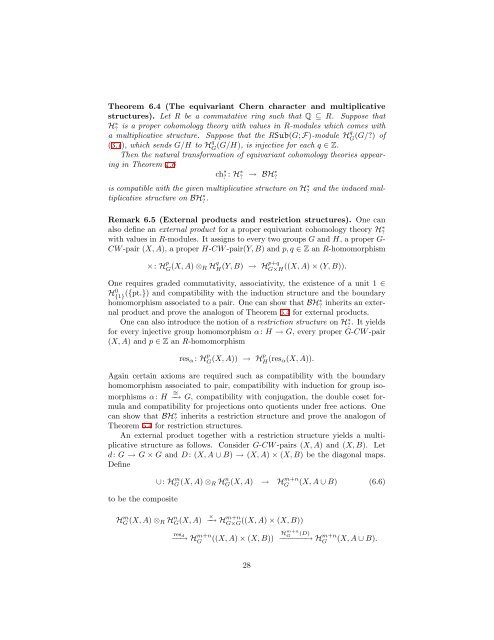Equivariant Cohomological Chern Characters
Equivariant Cohomological Chern Characters
Equivariant Cohomological Chern Characters
Create successful ePaper yourself
Turn your PDF publications into a flip-book with our unique Google optimized e-Paper software.
Theorem 6.4 (The equivariant <strong>Chern</strong> character and multiplicativestructures). Let R be a commutative ring such that Q ⊆ R. Suppose thatH? ∗ is a proper cohomology theory with values in R-modules which comes witha multiplicative structure. Suppose that the RSub(G; F)-module H q G(G/?) of(3.7), which sends G/H to H q G(G/H), is injective for each q ∈ Z.Then the natural transformation of equivariant cohomology theories appearingin Theorem 4.6ch ∗ ? : H? ∗ → BH?∗is compatible with the given multiplicative structure on H? ∗ and the induced multiplicativestructure on BH? ∗ .Remark 6.5 (External products and restriction structures). One canalso define an external product for a proper equivariant cohomology theory H ∗ ?with values in R-modules. It assigns to every two groups G and H, a proper G-CW -pair (X, A), a proper H-CW -pair(Y, B) and p, q ∈ Z an R-homomorphism×: H p G (X, A) ⊗ R H q H(Y, B) → Hp+qG×H((X, A) × (Y, B)).One requires graded commutativity, associativity, the existence of a unit 1 ∈H{1} 0 ({pt.}) and compatibility with the induction structure and the boundaryhomomorphism associated to a pair. One can show that BH? ∗ inherits an externalproduct and prove the analogon of Theorem 6.4 for external products.One can also introduce the notion of a restriction structure on H? ∗ . It yieldsfor every injective group homomorphism α: H → G, every proper G-CW -pair(X, A) and p ∈ Z an R-homomorphismres α : H p G (X, A)) → Hp H (res α(X, A)).Again certain axioms are required such as compatibility with the boundaryhomomorphism associated to pair, compatibility with induction for group isomorphismsα: H −→ ∼= G, compatibility with conjugation, the double coset formulaand compatibility for projections onto quotients under free actions. Onecan show that BH? ∗ inherits a restriction structure and prove the analogon ofTheorem 6.4 for restriction structures.An external product together with a restriction structure yields a multiplicativestructure as follows. Consider G-CW -pairs (X, A) and (X, B). Letd: G → G × G and D : (X, A ∪ B) → (X, A) × (X, B) be the diagonal maps.Defineto be the composite∪: H m G (X, A) ⊗ R H n G(X, A) → H m+nG(X, A ∪ B) (6.6)H m G (X, A) ⊗ R H n G(X, A)res dG×−→ H m+n ((X, A) × (X, B))G×GH m+nG (D)−−→ Hm+n((X, A) × (X, B)) −−−−−−→ H m+n (X, A ∪ B).G28
















